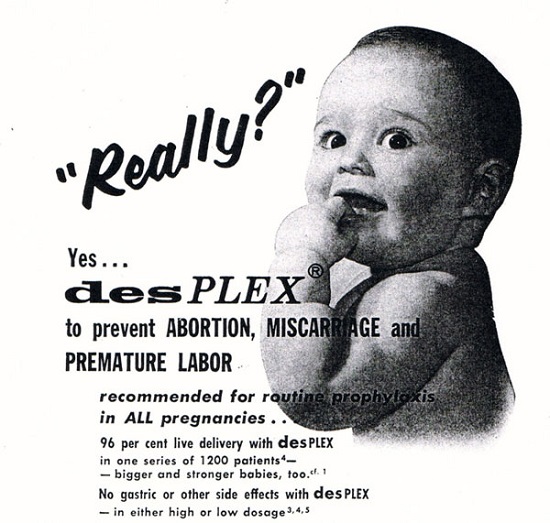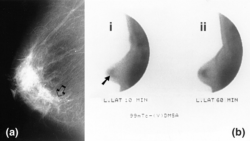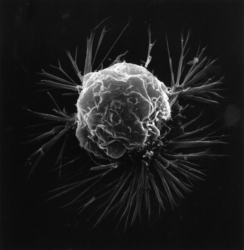DES is a synthetic estrogen-like compound developed in 1938 by English chemist Charles Dodd. German chemists under the employ of the Nazis were able to synthesize DES cheaply and easily from coal tar and used it to fatten livestock. There was a problem, however. The young boys who cared for the livestock, and thus were exposed to the chemical, developed swollen and painful breasts, a condition now called gynecomastia. This would be one of many indications that perhaps the drug was not as safe as proclaimed. The German solution to avoid this side effect was to have women care for the animals because they had breasts already, after all. An American scientist in the employ of several American industrial interests and with ties to German researchers during and after the war, concurred:
“A drug effect of interest in relation to industrial hygiene is that of DES, the manufacture of which only female workers are employed, because untoward effects induced in males by the absorption of this material in the course of a day’s work. Boys develop a mammary swelling with such severe pain and pressure of a shirt cannot be endured. On the discontinuance of exposure the condition subsides spontaneously within a week or two. No sequelae have been reported and no abnormalities of the testes have been seen. On the other hand, older males develop some atrophy of the testes and some apparently temporary loss of sexual potency. This condition is said to have been cured by the administration of androsterone. Exposed women had no nausea or menstrual abnormalities.” The Secret History of the War on Cancer, pp 90.
Despite the early indicator that DES might not be safe, and without any other testing beyond the basic toxicology to determine lethality, it was approved by the FDA in 1941 for vaginitis and as an early hormone replacement therapy for menopausal women. It was later approved a variety of low estrogen indications. In 1947, the FDA approved its use in pregnant women with a history of miscarriage. DES had been used off-label for miscarriage prevention since the early 1940s, despite the fact that little evidence supported its use and animal studies indicated clear carcinogenic and congenital reproductive abnormalities in the offspring. Indeed, years before the development of DES, the relationship between synthetic hormones and several forms of cancer, were recognized. Nevertheless, the promise of pharmaceutical industry profit overrode any potential long term consequences of the drug.
After 10 years of widespread use and marketing, a double-blind, placebo-controlled study on the efficacy of DES was finally conducted. As one might expect, it was found ineffective in preventing miscarriage. In fact, women on DES had a higher risk of miscarriage. Later studies in the 1960s began detailing the adverse effects this drug. Nevertheless, despite mounting evidence of the dangers of diethylstilbestrol, it remained on the market and widely used through the early 1970s in the US and into the 1980s in some European countries. In the US alone, it is estimated that some 5-10 million women and their children were exposed to DES. Because the compound was never patented, 287 drug companies sold DES under a multitude of brands and for an array of low-estrogen conditions.
Two decades after both the Germans and the English recognized that DES caused gynecomastia in the male farm hands, US reports of gynecomastia and sterility in US poultry workers were evident. As a result, the FDA banned it for use in poultry under the newly enacted Delaney Clause to the FDA 1958. It would be another 13 years before DES was banned during pregnancy and 20 years before DES was banned in cattle. That means that neither the evidence that DES was ineffective in the prevention of miscarriage but may actually increase risk, nor the evidence of congenital abnormalities and cross-generation cancer risks were sufficiently troubling to initiate its ban. DES was finally banned for use in cattle until 1979. It would be years after before it was removed from the food chain (if it even is now). “In 1980, half a million cattle from one hundred and fifty-six feedlots in eighteen states were found with illegal DES implants.” Even upon FDA’s decision to withdraw its approval of DES in cattle and feed, it did so on grounds of the procedural non-compliance of the manufacturers, while simultaneously maintaining the safety of DES, “because there is no evidence of a public health hazard.” Even now, despite its clear carcinogenic and teratogenic risks, it is still used in veterinary care.
DES represents just one of many pharmaceuticals marketed as safe upon the flimsiest of measures. It was a known carcinogen before its approval. By 1939, 40 papers had been published detailing its carcinogenic activity. Unfortunately, they were countered heavily by industrial interests with some 257 papers published within the proceeding two years touting its benefits. As is the case today, the influence of advertising to skew public opinion, whether the medical public or lay public, was intense and ultimately successful. Even though the evidence suggesting DES prevented miscarriage was highly controvertible, it was approved by the FDA and adopted wholeheartedly by the medical industry. Even when it was proven ineffective at preventing miscarriage in 1953, it was still prescribed regularly.
“…doctors continued to widely prescribe DES in normal pregnancies like ‘vitamins’ or ‘a little extra insurance.’ They continued because of the highly aggressive sales tactics of pharmaceutical representatives and because it was widely advertised in medical journals and the popular press. Influenced by the advertisements, and in their desperate desire to avoid miscarriages, women demanded DES.”
It was not until 1971, that the FDA finally recognized the risks. DES, like thalidomide, DDT, and other chemicals developed during this period, are often viewed through the lens of history as representative of a bygone era, when science and technology were yet nascent endeavors. I would argue that is incorrect. While it is true that science and technology have advanced significantly in recent decades, what remains steadfast are the cultural and monetary conflicts that motivate and define what is accepted as true in this field; and sadly, what is accepted as true is whatever industry tells us.
We Need Your Help
More people than ever are reading Hormones Matter, a testament to the need for independent voices in health and medicine. We are not funded and accept limited advertising. Unlike many health sites, we don’t force you to purchase a subscription. We believe health information should be open to all. If you read Hormones Matter, like it, please help support it. Contribute now.
Yes, I would like to support Hormones Matter.
This article was published originally on October 23, 2019.















I am a DES daughter. Born in 1959 in Omaha Nebraska. I was fortunate. I have 3 sons. My only grand daughter now 13 is presenting with some menstrual issues I suffered. In 2006 I had a total hysterectomy. My presenting symptom was complete uterine prolapse severe enough to damage other pelvic structures. Again I was fortunate. I was able to locate an OB GYN highly qualified and known for his expertise in DES issues. I have struggled with weight throughout my life. I suffer from insomnia and eyesight problems and wonder if they could be DES related. I’m very grateful for your publication. I can give a small donation. I quit my profession as a RN because of what I witnessed in the hospital regarding covid. I am in the fight against medical tyranny and pharmaceutical fascism. Believe me when I tell you we are at war. Please feel free to contact me if you wish. Again. Thank you
Bob Dylan —
Come you masters of war
You that build the big guns
You that build the death planes
You that build all the bombs
You that hide behind walls
You that hide behind desks
I just want you to know
I can see through your masks
–“Masters of War,” Bob Dylan
A good book here — The Alsos officials made copious notes, writing down the names of scientists involved in these projects. Their goal wasn’t to bring these scientists to justice for their evil experiments. They were creating a list of scientists to track down, capture and interrogate. The United States was determined to learn what it could do about the diabolical weapons they were inventing.
“One by one, across the Reich,” explains journalist Annie Jacobsen in her book Operation Paperclip: The Secret Intelligence Program to Brought Nazi Scientists to America (Back Bay Books: 2014), “Hitler’s scientists were taken into custody and interrogated.”
Two core goals emerged among Allied officers uncovering the extent of the carnage and horrors in Europe created by the Nazi regime. Many sought Nazis to arrest and bring to justice. At the same time, a key US and Allied goal was also to harness Nazi scientists’ technical know-how. “The scale on which science and engineering have been harnessed to the chariot of destruction in Germany is indeed amazing,” noted W.S. Farren, a British aviation expert with the Royal Aircraft Establishment. “There is a tremendous amount to be learnt in Germany at the present time.”
Operation Paperclip
On July 6, 1945, the US Joint Chiefs of Staff issued a top-secret memorandum that was so explosive it was never even shown to President Truman. Titled “Exploitation of German Specialists in Science and Technology in the United States”, it outlined a program for “procurement, utilization and control of specialists” – in other words, a plan to recruit Nazi weapons scientists and bring them to the United States. The Military Intelligence of the War Department, a unit known as G-2, was given control of the program.
+–+
Then, Dow and Nazis — And Bush and Ford and, well, welcome to the USA! Read the ugly details of how these chemicals have come about, and why!
https://www.counterpunch.org/2020/08/06/how-the-fascists-won-world-war-ii/
I discovered the complex ties between IG Farben and Dow Chemical in 1966, while working to help create the movement against the use of napalm in Vietnam. Dow, of course, was the main producer of napalm. As I wrote then: “In the 1930’s, Dow Chemical and IG Farben formed an international cartel. Part of their agreement was to restrain U.S. production of magnesium and allow Germany to take world leadership in the vital element. As a result, at the outset of World War II Germany was producing five times as much magnesium as the United States.”
Could the guardian angels of IG Farben’s HQ be the same angels who saved IG Farben’s leading executives from execution or lifetime sentences? As Berlin Express was filming in Frankfurt, 140 miles away in Nuremburg twenty-three top IG Farben executives were being tried as war criminals. In the film, the Nazis are still the enemy. But by that time, America was already rebuilding German industry against a perceived menace from Soviet Communism.
Leading the charge against the prosecutors of IG Farben’s chieftains was Congressman George Dondero of Michigan, who asserted on the floor of Congress, that Josiah DuBois, the prosecution’s lead attorney, as well as five other members of the team, were all “Communist sympathizers” “who are trying to blacken the name of IG Farben.” Dondero’s Congressional district happened to include the Midland, Michigan, international headquarters of Dow Chemical, whose links to IG Farben were already being exposed in U.S. newspapers. On the same House floor, Congressman John Rankin of Mississippi branded the trial a “disgrace” where members of a “racial minority” are “trying German businessmen in the name of the United States.”
BASF, short for Badische Anilin und Soda Fabrik, was the main company that originally created and merged into IG Farben. When I was researching Dow Chemical and napalm in 1966, I learned that Badische Anilin und Soda Fabrick had renewed its relations with Dow and the two companies were now partners in the Dow-Badische company, with a giant chemical plant in Freeport, Texas.
As a member of the small delegation that met in 1966 with the executives of UTC, a Dow subcontractor with a huge napalm contract in the San Francisco Bay Area, I naively presented my research. Barnet Adelman, the president of UTC and a fellow Jew, responded in these exact words, the core defense of the IG Farben war criminals at Nuremberg: “Whatever our government asks us to do is right.”
When the leaders of IG Farben escaped any meaningful punishment for their monstrous war crimes (with their fortunes intact), the U.S. prosecutors dropped their pending case against Deutcshe Bank. As Germany’s largest bank, Deutsche Bank bankrolled the rise of Nazis and amassed colossal wealth from the genocide of the Jews and the takeover of foreign banks as nations fell to the Wehrmacht. Deutcshe Bank financed both the death camps and IG Farben’s slave labor factory at Auschwitz. As Jews and other victims were gassed by IG Farben’s Zyklon-B, their gold wedding rings and dental fillings were collected and melted down. Deutsche Bank then sold the gold, thus converting it into the hard cash desperately needed by the Nazi war machine. David Enrich’s Dark Towers: Deutcshe Bank, Donald Trump, and An Epic Trail Destruction reveals the sequel. After U.S. banks blacklisted Donald Trump because he had defaulted on many loans, Deutcshe Bank gave Trump loan after loan, through bankruptcy after bankruptcy, default after default, effectively financing his real estate empire.
Born in 1934, I have often wondered, over the decades, how fascism triumphed in Germany, arguably then the most advanced nation in the world. I guess we are beginning to understand. I hope it’s not too late.
Is there an upper limit for thiamin supplementation while breastfeeding? (Thiamine hcl pills)
My mood and energy seems stable only at 300 to 500 mg per day. Even though now I eat only whole foods (incl lots of animal fat and protein), I need that dose.
I have many health conditions going back to childhood, grew up eating processed junk food 3 meals a day, but wonder if I can take thiamin while breastfeeding my baby.
Thank you.
Jane, I think you meant to place this comment on one of Dr. Lonsdale’s posts. To answer your question though, no, this is no upper limit, within reason of course. Many folks take very high doses. It is entirely contingent on your individual circumstances, genetics, needs, etc.